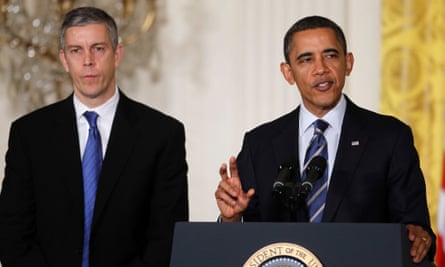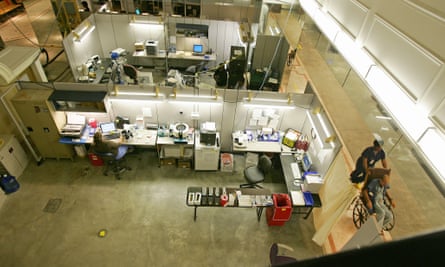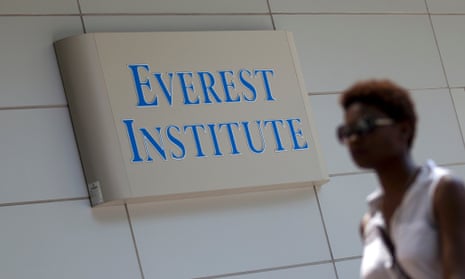By the time the Department of Education temporarily shut off the flow of student aid money to Corinthian Colleges Inc, one of the largest for-profit college companies in the country, 20 state attorneys general, several federal agencies and the department itself were investigating the sprawling chain.
Still, the regulators didn’t see the final implosion coming any more than the students did.
In response to the department’s move, which was supposed to be just a 21-day hold last month, Corinthian announced that it would likely fold, leaving around 72,000 students out of their time and tuition, and the American taxpayer potentially on the hook for $1bn in federally-backed loans.
Shocked, the DOE stepped in again, this time to supervise an orderly liquidation of the Corinthian’s college brands, the Everest, Heald and WyoTech schools. The department released $16m in student aid money to keep the schools open. In June, the department and Corinthian agreed that the company will sell off 85 campuses and slowly move to shutter the remaining dozen. The company just delivered plans on how it will close all of its schools, if needed. In the meantime, Corinthian can continue to enroll new students, so it remains attractive to prospective buyers.
Now, as campuses prepare to close and go up for sale, the for-profit education industry and its critics face some unpleasant realities. Corinthian couldn’t survive on the open market, but posed systemic risks to the industry and taxpayers. Corinthian, and perhaps others like it, are too big to fail, but may fail nonetheless.
"This could be setting a precedent for how the department deals with these companies in the future," said Robyn Smith, a staff attorney at the National Consumer Law Center who specializes in student aid and for-profit education issues.
Corinthian's dramatic fall also highlights a growing debate about how for-profits fit into the higher education mix.
Even some liberal education commenters – many of whom have been fierce critics of for-profit colleges – acknowledge to some degree that the schools are needed to meet growing demand for workers in sectors such as healthcare.

For-profit colleges train many healthcare support positions. For example, the industry is heavily concentrated in certificate granting programs, such as in training medical assistants. That occupation is expected to add 162,000 jobs over the next 10 years, according to the Bureau of Labor Statistics. Urdan said as many as 40% of the America's medical assistants train with for-profit colleges. Overall, healthcare support positions are are expected to grow by 1.1m in 10 years.
“The student wants to get a particular type of degree,” said Kevin Kinser, senior global education policy researcher at New York’s University at Albany. “In medical assisting, or something along those lines, they don’t have any options outside of the for-profit sector because that’s pretty much where that kind of training takes place.”
“We could go overboard in demonizing for-profits,” said Tim Bates, a program analyst for the Center for Health Professions at the University of California, San Francisco, at a 2011 expert panel covered by Inside Higher Ed. “Over-regulation may limit access to people,” he said about for-profits' role in educating minority, low-income and older students.
The department’s agreement with Corinthian leaves students on shifting ground, and with few options.
Students with the least flexibility could be those whose campuses are sold and remain open. For example, if one of Corinthian’s buyers discontinue a program of study students must repay loans. They could be left in debt with credits that are unlikely to transfer.
Students wishing to discharge private loans will have to embark on a state-by-state fact-finding mission. The Department of Education does not forgive private loans even if schools close. Students will need to contact lenders and their state department of education.
If a campus closes in what is sometimes called a “teach-out” – the campus is closed after every student has moved on or been moved on – some students will be eligible for loan forgiveness from the DOE. For example, a student who refuses to participate in a campus teach-out could qualify some students for loan forgiveness. The agreement could also reimburse some students’ federal grants, such as Pell Grants, an unusual measure. Usually, grant money isn’t reimbursed even when schools close.

Loan forgiveness is where the agreement would begin to impact taxpayers. Corinthian is contributing to a $30m fund to pay for costs of forgiven loans.
The DOE appointed financial monitors to avoid that, led by former US attorney Patrick Fitzgerald. Now of the law firm Skadden, Arps, Slate, Meagher & Flom LLP, Fitzgerald is best known for having prosecuted Lewis “Scooter” Libby after the outing of CIA agent Valerie Plame.
"They’re mostly low income students and so a more unsophisticated population, but I think any student in this situation would be at a loss, and it is a complex situation," said the National Consumer Law Center’s Smith.
Smith is among many calling to stop allowing new students to enroll in Corinthian schools for now, a measure that analysts say would make the corporation’s parts more difficult to sell. A dozen senators and the California attorney general have also called for an enrollment halt.
Students are now being notified of Corinthian’s status, and the corporation is continuing to advertise and recruit students. It’s difficult to predict the impact on new enrollees – more schools could close in the future, others may not be recertified to receive student aid, some may be purchased and change programs of study.
But Corinthian’s schools were never a bargain.
Tuition for a two-year degree tops out at $40,000. On average, the cost at community college is $6,528. Corinthian’s least expensive certificate for healthcare was $17,000. Only 10% of all for-profit college students nationally graduate without debt; 70% of certificate-holding community college students do the same, according to College Board.
Loan default rates for students emerging from Corinthian’s schools, which are high though below the for-profit average, have concerned consumer advocates for years.
"The state agencies appeared to have been asleep at the wheel," said Smith. "The department has known since November 2012 that Corinthian was failing at its financial responsibility score."

In 2010, the last year for which data is available, students at Corinthian defaulted at an average rate of 19%, a marked improvement from the 2009 Corinthian average, of 28%. In 2010, the industry average was 21.8%, and the national average, including state and not-for-profit schools, was 14.7%.
It’s easy to imagine how it could be difficult to keep up with loan payments. Medical assistants, for example, make around $14 per hour.
“There is no doubt that after the 2008-09 economic crisis, when unemployment went up and jobs were hard to come by, we did indeed have an issue with cohort default,” said Kent Jenkins, a Corinthian spokesperson. “That cohort default is down over the last two or three years.”
Just a few years ago, before the company's protracted fall into penny-stock-dom, Corinthian might have been considered a safe bet for investors.
A small group of for-profit higher education insiders founded the company in 1995.
Corinthian quickly acquired 18 of campuses from another for-profit, went public in 1998 and experienced astronomic growth. By 2000, it had 44 campuses and revenue had grown from $31m to $170m. In 2004, the company pulled in $804m and its stock was at $35.37. Its revenue crossed $1bn in 2008, and hit its high-water mark in 2011 at $1.7bn with 114 campuses.
"After the recession, you had two years, 2009 and 2010, of unprecedented levels of enrollment and revenue," said Trace Urdan, a for-profit education analyst at Wells Fargo Securities. During the recession, "everybody went back to school", said Urdan. Wells Fargo is also Corinthian's largest investor.
"What’s supposed to happen, is those people move into jobs, and there’s a recovery," Urdan said.
But Corinthian started to go into the red in 2011, when it lost $111m. In 2012, the company posted negative $10m, and was down $1.6m in 2013. Urdan attributed the losses to sector-wide contraction.
"There were no jobs for those people to move into … So that creates a negative feedback loop," Urdan said. In other words, without jobs for graduates, placement rates fall and default rates rise. That prompts tighter scrutiny from government and accreditors, and hurts the company's enrollment, image and stock price.
Corinthian became the subject of an investigation by the California state attorney general in 2007. Since 2010, it’s fielded requests and subpoenas from 20 states attorneys general. It's also been subject to inquiries by the Consumer Financial Protection Bureau, the Justice Department, the Securities and Exchange Commission and accrediting agencies.
Most of the inquiries were looking into allegations of inflated job placement numbers, aggressive marketing tactics and altered grades and attendance. The DOE says Corinthian admitted to faking job placement numbers – Corinthian disputes that.
One strategy a Corinthian school allegedly used to boost placement numbers was to pay local employers near Decatur, Georgia, $2,000 a head to hire graduates for 30 days, according to a Huffington Post investigation. That campus is now closed.
In California, the state attorney general alleged Corinthian used temp agencies to hire grads and boost its placement rates, according to a lawsuit.
Keeping up job placement numbers was doubly important for Corinthian – not only did it help attract new students, it also ensured accreditation and thus the company’s continued access to federal funds, which composed more than 80% of the company’s revenue. When the DOE halted funds to Corinthian, on 22 June, it was investigating claims the company faked jobs numbers and altered grades and attendance, and failed to provide documentation for placement rates.
Some observers believe the schools’ story reflects the questions now surrounding a changing industry.
“From my perspective, we really still haven't hit bottom yet,” said Kinser. “We don’t really know what the new for-profit sector in the United State is going to look like. It’s certainly going to look a lot different than it looked five years ago.”
For-profit schools are fighting a two-pronged challenge. Enrollment at for-profit schools dropped 12% between 2010 and 2012, some analysts say as a function of regulatory changes. For-profit schools are no longer allowed to pay recruiters based on how many students enroll. Regulations proposed by the DOE would connect companies’ student aid eligibility to graduates’ earnings and default rates. Kinser believes that could threaten for-profits’ very business model.
“What we were seeing was that new student recruitment was sometimes 60, 70, 80% of their current enrollment,” Kinser said. “From a business model perspective, that’s a very profitable company, from an educational institution perspective, it’s a pretty dismal failure.”
Regulating growth is one proposed solution, Kinser said. “An institution can go from 5,000 students to 50,000 students in a couple years.”
"This is already an incredibly volatile sector from the standpoint of publicly traded stocks," said Urdan. Referring to the agreement between Corinthian and the department of education, he said, "There's a list of stakeholders, and investors and lenders are not included on that list at all, and that’s sort of chilling in itself."

Comments (…)
Sign in or create your Guardian account to join the discussion